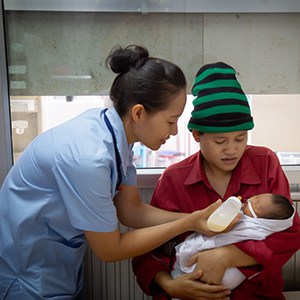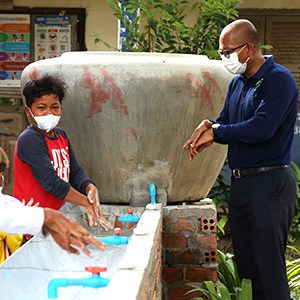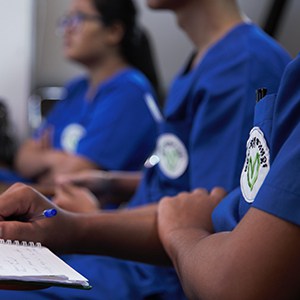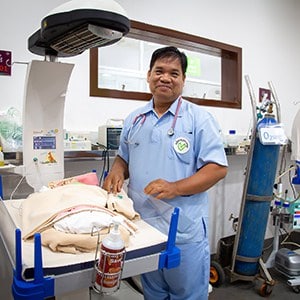Two-year-old Mengleang lives in Serei Saophoan, Banteay Meanchey Province, about 100 kilometers from AHC. Mengleang lives with his mother Malai, a housewife, his father Visal who is a motor-taxi driver, and his older sister Sreyroth, who is 19 years old and preparing to graduate high school.
In early May 2022, Mengleang and his parents visited his cousins. They were playing in the kitchen and Mengleang accidentally tripped backwards into a boiling pot of rice porridge. They rushed him to a private clinic nearby, where he was referred to the provincial hospital. There, he received first-aid support and was recommended to head to Siem Reap, where there is advanced equipment and expertise to treat burns.
Malai and Visal decided to try AHC for the first time, as their previous experiences at other Siem Reap hospitals were not the best. The accident occurred around 6 pm, and Mengleang and his family finally arrived at AHC’s Emergency Room at midnight.
“For a second, I did not think he was going to survive. I felt hopeless and blamed myself for this accident,” shared Malai. “A part of me thought maybe it would be better if he died. I did not want to bring him to a hospital. Surviving would mean a life of bullying from society.”
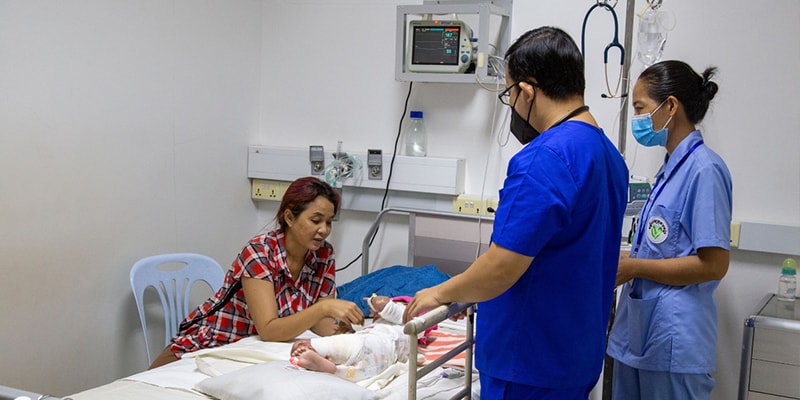
After the initial assessment, AHC’s ER team concluded Mengleang has second-degree burns on 50% of his body. The epidermis and parts of his dermis skin layer were damaged. Mengleang began to receive dressing changes (fine mesh gauze in combination with topical antimicrobials, to cover the burn wound) every two days while both surgical and ICU teams checked for any burn and skin problem development. Mengleang stopped being vocal and became inactive.
“It was very painful to be looking after him in bed with bandages all over his body. He did not answer me when I talked to him. Sometimes I sat beside his bed, looked at him and just cried,” shared Malai.
shared Malai.
Unfortunately, Mengleang’s condition worsened on his tenth day of admission as he vomited and developed a fever. A closer inspection showed that Mengleang’s stool had infected the burns around his anus. On his 14th day, Mengleang’s condition deteriorated and his fever reached 40◦C. He began to hallucinate. Results of his blood culture tests confirmed Mengleang had developed sepsis with Psedomonas in his skin and blood. At this point, his survival looked grim, but AHC’s medical teams did not give up.
“This case is very complicated and challenging for us, but all of us- my colleagues and Mengleang’s family have persevered. We are all in this together; we see Mengleang as our own child. Besides antibiotics, following our processes is extremely important. Without them, Mengleang would not have had the chance to improve or survive.”
Dr. Meas Vorlak, AHC’s Chief of ICU shared,
To treat sepsis, Mengleang received Meropenem, a broad-spectrum antibiotic to help fight off the bacteria.
Unfortunately, Mengleang’s complications did not end there. His burns became dry, thick, leathery, and black in color. He had developed skin necrosis (premature death of cells). AHC’s surgical team performed a debridement process to remove dead, infected, and black tissue from his body.
After twenty days of hospitalization, Mengleang’s infected areas had spread to all three skin layers: epidermis, dermis, and fat, now categorizing his burns as third-degree. Because third-degree burns damage nerve endings, Mengleang could not feel pain in the areas of the burns. AHC’s surgical team decided to perform a split-thickness skin graft using healthy, uninfected donor sites from Mengleang’s outer thighs and forearm muscles.
After continuing his antibiotic treatment for sepsis and undergoing three operations to help his burned and infected skin, Mengleang’s overall health saw a sign of recovery. The result of a second blood culture test showed no signs of a bacterial infection. Mengleang began to be active and talk to his parents again. The team hoped to undergo another round of skin grafting, but Mengleang’s donor sites could not allow for another operation as most of his skin and tissue were damaged.
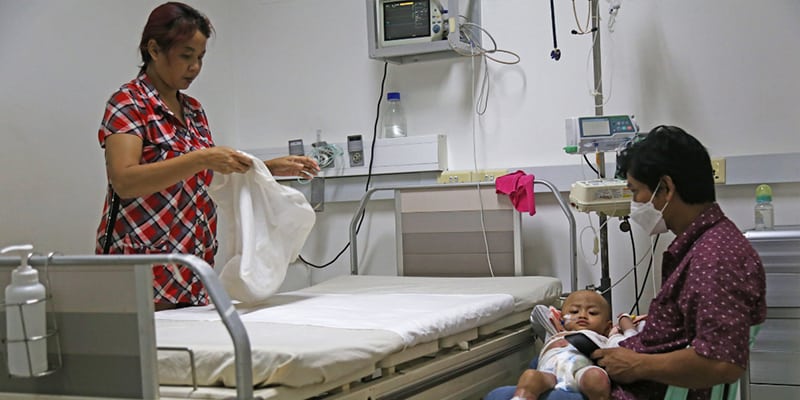
“From the first moment we arrived, the doctors and nurses at AHC welcomed us with open arms,” shared Malai. “They didn’t ask any questions, just rushed him inside and discussed how to treat my son. Everyone here treats him as if he is their own child. I am shocked and grateful by how compassionate, careful and knowledgeable they all are.”
Mengleang and his parents are now in an isolated room in AHC’s ICU. They have stayed at AHC for over 60 days. Along with continuous support from AHC’s nutrition team, the dressing change every two days continues to help him heal naturally. He is getting better every day. AHC’s ICU team hopes to discharge him in the next two weeks.
“Although Mengleang will experience challenges, we will continue to support him in his recovery journey with follow-up appointments,” shared Dr. Farilend, AHC’s surgeon. “When his condition improves, we hope to call him back for another round of skin graft operations to ensure he will be safe, healthy, and have the best skin possible.”
